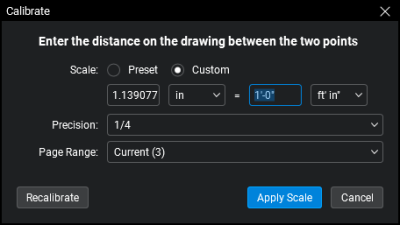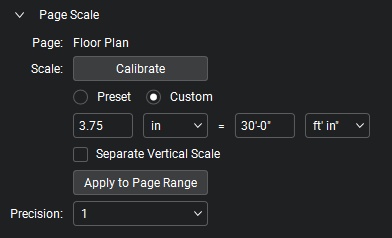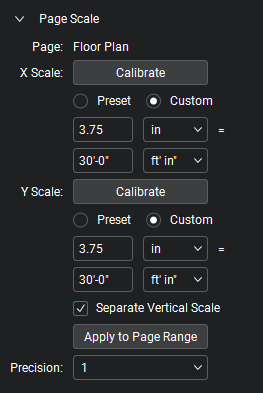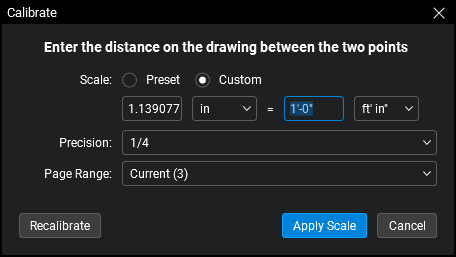Calibrate
The Calibrate tool allows Revu to determine a PDF's scale, enabling accurate measurements.Revu can calibrate a PDF to a single scale or to separate X and Y scales as needed.
Calibrating a PDF usually entails a single scale for all measurements. To calibrate separate X and Y scales, see Calibrating Separate X and Y Scales below.
To calibrate a PDF:
- Go to Tools > Measure >
 Calibrate. The Calibrate tool opens.
Calibrate. The Calibrate tool opens.- Alternatively, click Calibrate on the Measurement panel.
- A dialog box might appear with instructions regarding the use of the Calibrate tool. If it does, click OK.
-
Locate a measured length on the page. Click the first point of the known length, then click the second point to finish the line. Hold down SHIFT to snap the two points horizontally, vertically, or diagonally (as appropriate). When the second point is selected, the Calibration dialog box opens.

-
Enter the distance that the line between these two points represents on the drawing and select the units in which measurements are to be reported.
- Select the decimal or fractional precision of the measurement values from the Precision menu.
- Select the Page Range to which to apply this scale. Each page in a drawing can have its own scale.
- Click OK.
Note: If you are working with a vector-based drawing (as opposed to a scanned PDF), you can enable Snap to Content which makes the cursor snap to the underlying lines and drawing elements, making it much easier to accurately select the two points.
Alternatively, if you already know the PDF's scale, you can enter it in the Scale section of the  Measurements panel.
Measurements panel.

Using the Calibrate tool is recommended, however, as sometimes scaling occurs during the PDF creation process.
PDF can be calibrated with separate X and Y scales. To do so:
- Go to Window > Panels >
 Measurements or press ALT+U to show the
Measurements or press ALT+U to show the  Measurements panel.
Measurements panel. -
Select Separate Vertical Scale. Separate scales appear for both X and Y.

- If the X or Y scale is known and you are certain no scaling has occurred during the PDF creation process, and the scale is common:
- Select Preset for the X scale or Y scale, as desired.
- Select the scale from the menu that appears.
- If the X or Y scale is known and you are certain no scaling has occurred during the PDF creation process, and the scale is not common, you can input them manually:
- Select Custom for the X scale or Y scale, as desired.
- Enter the scale in the fields provided.
- If you are not certain of the scale or would otherwise prefer to calibrate the scale to the document directly:
- Click Calibrate for either the X scale or Y scale, as desired, to use the Calibrate tool.
- A dialog box might appear with instructions regarding the use of the Calibrate tool. If it does, click OK.
- Click the first point of the known length, then click the second point to finish the line. Hold down SHIFT to snap the two points horizontally, vertically, or diagonally (as appropriate). When the second point is selected, the Calibration dialog box opens.
Enter the distance that the line between these two points represents on the drawing and select the units in which measurements are to be reported.

- Click OK.
- Click Calibrate for either the X scale or Y scale, as desired, to use the Calibrate tool.
- Repeat for the other scale.
- Select the Page Range to which to apply this scale. Each page in a drawing can have its own scale.
- If desired, set the Precision, which determines the decimal or fractional precision of the measure value displayed.
If Separate Vertical Scale is unchecked later, the scale set for the X Scale will automatically be used for both X and Y scales. However, existing measurements will not be affected.